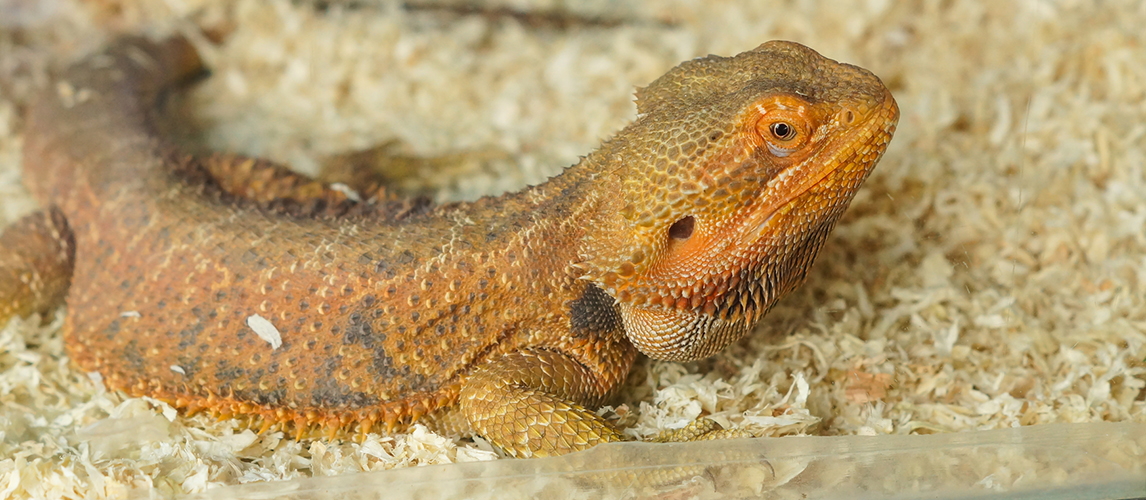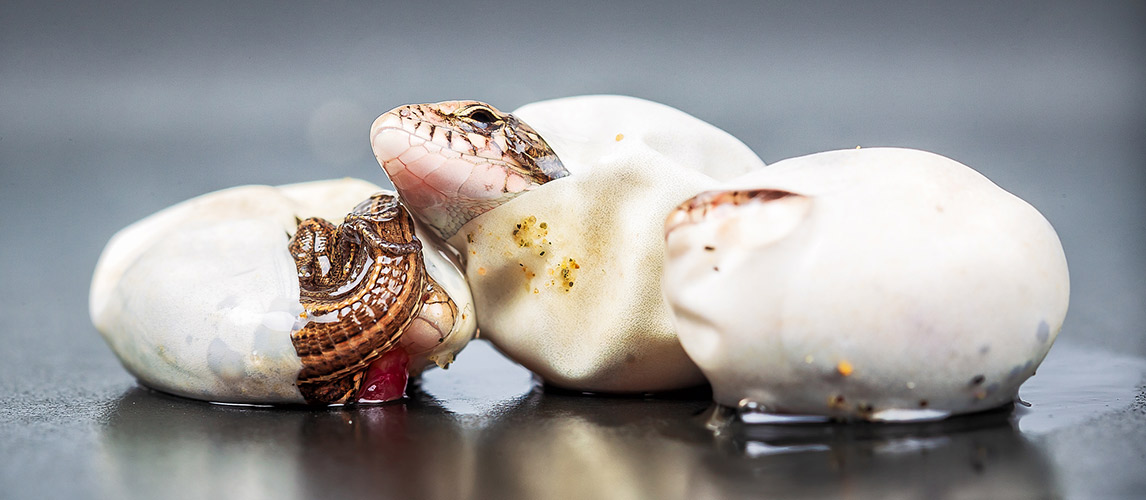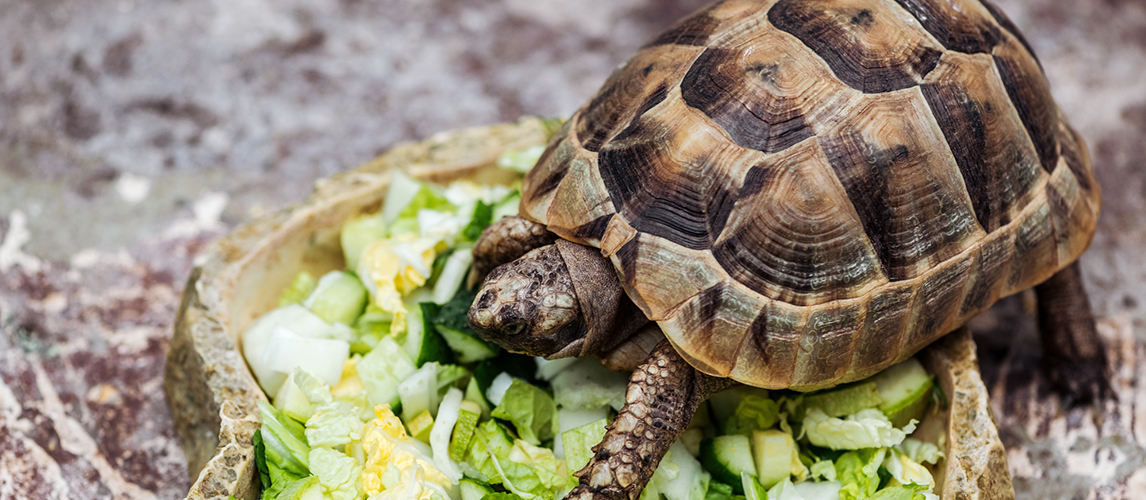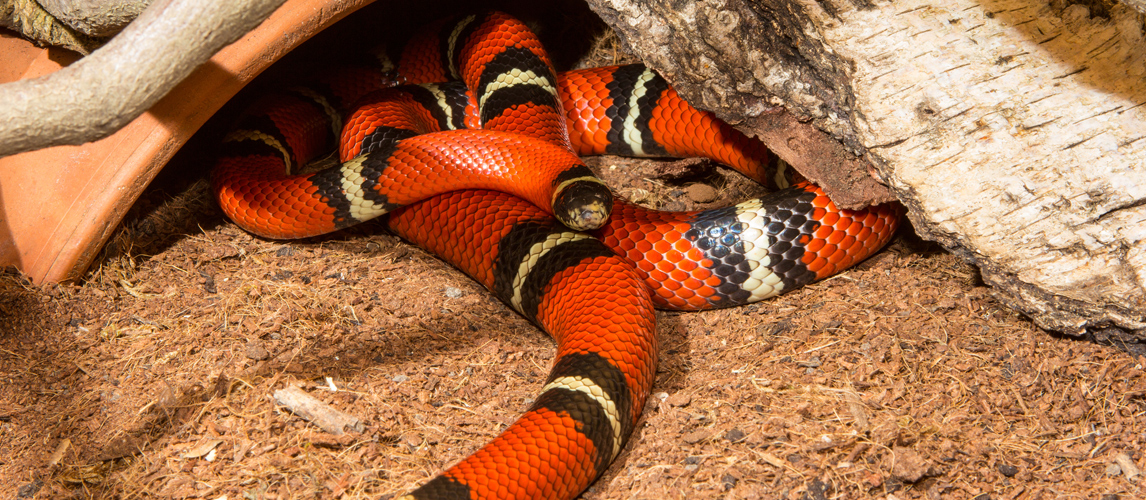
The Best Reptile Thermostats in 2022
- Home
- Other animals
- Reptiles
Reptiles are fascinating and very rewarding animals to keep as pets but you have to do your homework. You need to research how to look after them correctly and a big part of this is maintaining the correct temperature within their vivarium or tank.
Reptiles are ectotherms which means that they are cold blooded. They cannot warm themselves up, instead they rely on external heat sources. In nature, they would bask in sunlight on hot rocks but in captivity, you will have to provide a heat source for them. It is not just a case of turning on a heat source and walking away because it may not be at the correct temperature for your reptile. They all have different ideal heat ranges and do not cope well with fluctuations in temperature. This is why a reptile thermostat is so useful. It will help you to maintain a consistently correct temperature. To help you make the right choice, check out our guide to the best reptile thermostat.
The Best Reptile Thermostat
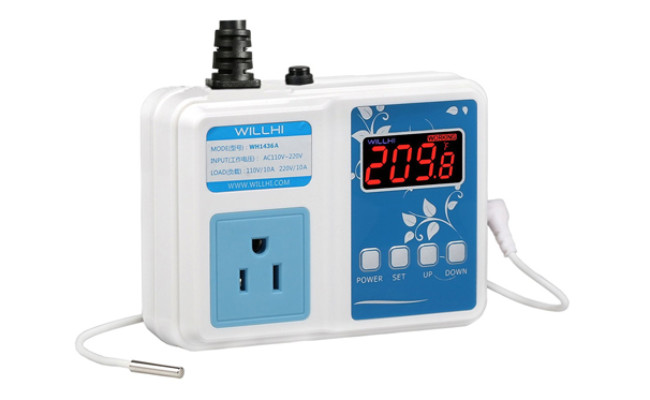
This is a very simple to use reptile thermostat that you plug in and it’s ready to go with no fiddly or complicated wiring. It fits the standard US power outlet and has a maximum power load of 1100W at 110V. It can be used with a heating or a cooling device and has a power consumption of less than 3Watts. The sensor cable is 9.8 feet long.
This thermostat has a read out that can be set to Celsius or Fahrenheit temperature. You simply position the temperature probe (which is waterproof and durable), turn on your heating/cooling device and set the thermostat to the desired temperature. It will activate at one temperature and turn the heater off at another. The difference of the temperatures can be 2 degrees and can be a minimum -58 degrees F to 230 degrees F giving you a wide control range. The device has an accuracy of 0.5 and can be calibrated. For added safety, there is a high and low temperature alarm and an auto shut off timer.
Can be used with heating and cooling devices
Wide temperature range
Durable probe on 9.8 feet long cable
Ready to use with no complicated wiring
- Brand: WILLHI
- Model: WH1436
- Weight: 15.2 ounces
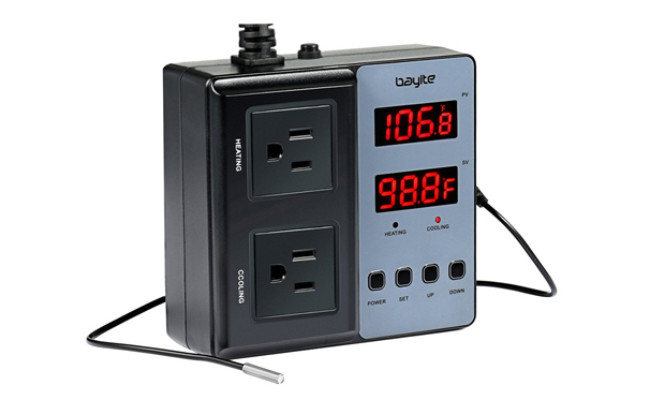
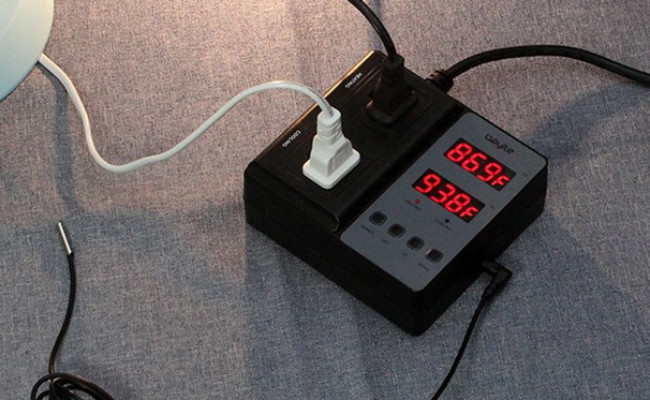


Use this temperature controller to turn heating and cooling devices on and off to achieve the best temperature for your pet reptiles. It comes with a comprehensive manual and temperature read out is in degrees Celsius or Fahrenheit. It can be used with one device and has a robust temperature probe with a 9.8 feet cable.
The thermostat uses less than 3 Watts of power and needs an AC 110V 50/60Hz power supply. It can measure temperatures ranging from -58 degrees F to 230 degrees F with an accuracy of 0.5. The most that the span can be between turning on and turning off is 25 degrees. It features both high and low temperature alarms.
Works with heating and cooling devices
Ranges from -58 degrees F to 230 degrees F
High and low limits can span 25 degrees
High and low temperature alarms
- Brand: bayite
- Weight: 1.3 pounds
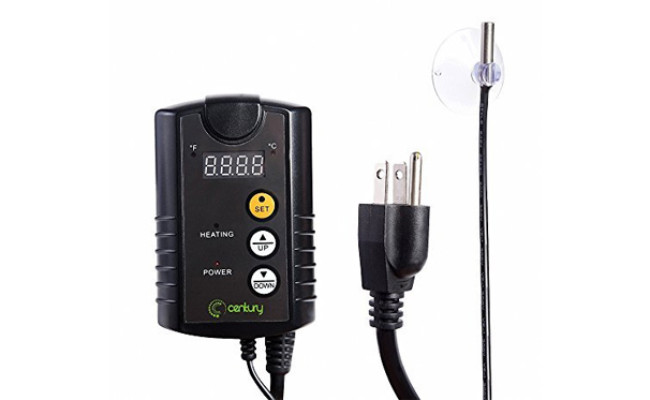
This is an easy to use unit that effortlessly maintains your required temperature for your reptile. All you have to do is plug it in and then use the three control buttons to select your desired temperature. The display can be given in Fahrenheit or Celsius on an LED digital display so you can see what is happening even in the dark. It has a hanging tab which is very convenient and the temperature probe has a 6 feet long cord.
The outlet is grounded and three pronged so it can be used with just about any heat mat or heat lamp. It will control temperatures between 40 degrees F and 108 degrees F and will display temperatures of between 32 degrees F and 140 degrees F. Its power rating is 120VAC 60Hz.
Digital LED display
Convenient hanging tab
Control temperatures between 40 degrees F and 108 degrees F
Grounded three-pronged outlet
- Brand: Century
- Model: T7(H)
- Weight: 1.14 pounds
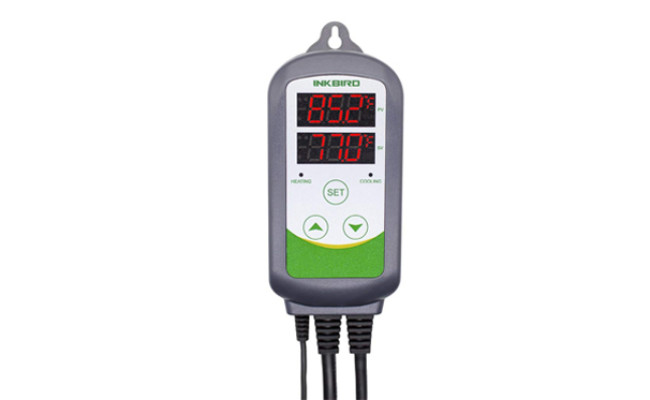
Here we have a very compact unit on which you can set your required temperature range. Then you just plug it in and place the probe in an appropriate position before plugging a heating or cooling unit into the device’s outlet. If you wish, you can connect a refrigeration unit and a heating device at the same time.
The thermostat is easy to calibrate and will display the temperature as either Centigrade or Fahrenheit. It has a temperature control range of between 58 degrees F and 210 degrees F with an accuracy of plus or minus 1 degree F. It requires an input power source of 100 ~240VAC, 50Hz/60Hz. The unit comes with a 6.56 feet sensor cable and features an alarm that sounds at a high and low temperature. It also has a sensor fault alarm for added safety.
Compact thermostat unit
Can be used with two devices for heating and cooling at the same time
Temperature control range of between 58 degrees F and 210 degrees F
High and low temperature and sensor fault alarms
- Brand: Inkbird
- Model: SYNCHKG084064
- Weight: 12 ounces
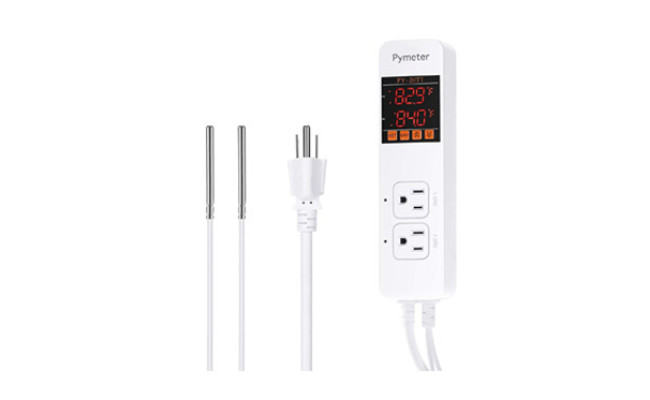
The Pymeter digital temperature controller is supplied with two waterproof sensors that are highly accurate so you can control two sockets for a heater and a cooler at the same time but you could also use it separately when you need to. Because each outlet has an independent temperature controlled switch, it can identify the heating or cooling mode using the ON & OFF set-point. This gives you ultimate flexibility to attain your desired temperature range to keep your reptiles comfortable and happy.
For ultimate safety, there is a both a high and low temperature alarm and a temperature difference alarm to guard against a malfunction. This model comes with a host of additional functions including a power-off memory, a power-on delay and a temperature calibration.
Two waterproof sensors
Highly accurate
High and low temperature alarms
Power on delay
- Brand: Pymeter
- Model: PY-20TT
- Weight: 1.04 pounds
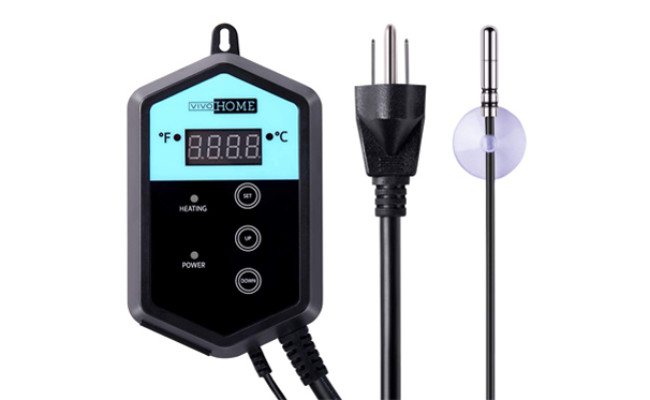
Keep your reptiles healthy and comfortable with this thermostatic controller which keeps their environment at the same temperature as their natural habitat. It has a lit LCD screen display that makes it easy to check what the temperature is and set the required temperature.
All you have to do is plug a heating mat into the thermostat and put the temperature probe into the desired location within your reptile enclosure. To set it up, you just need three buttons and it is compatible with most heat mats. It requires a 120 V/60 Hz power supply and can be set at anything from 68 to 108 degrees F. The temperature probe has a 77 inch cable.
Lit LCD screen display
Compatible with most heating mats
Operated by three buttons
Maintains temperatures at 68 to 108 degrees F
- Brand: VIVOHOME
- Weight: 13.6 ounces
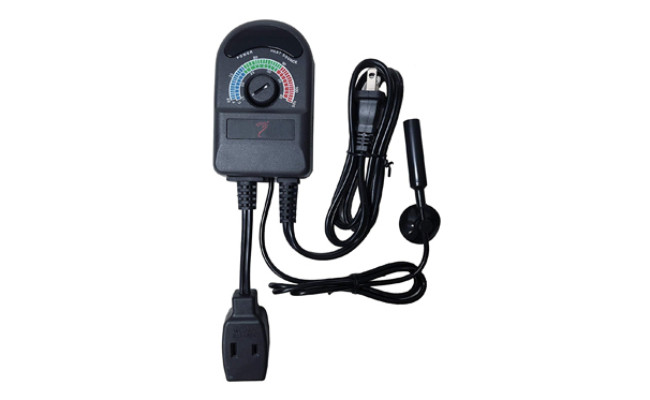
This is a low cost and simple device that will take up very little space in your home. It can control up to 1000 watts of power and has three power outlets. It will maintain a consistent temperature for your pet at anything between 68 degrees F and 95 degrees F.
As well as its use for reptiles and other small pets, it can also be used for seed germination and home brewing. The unit features an LED heating indicator light. It is exceptionally easy to set the temperature control and it comes with an external probe and cable.
Controls up to 1000 watts of power
Maintains temperature at between 68 degrees F and 95 degrees F
LED heating indicator light
External probe and cable
- Brand: Encompass All
- Weight: 8 ounces
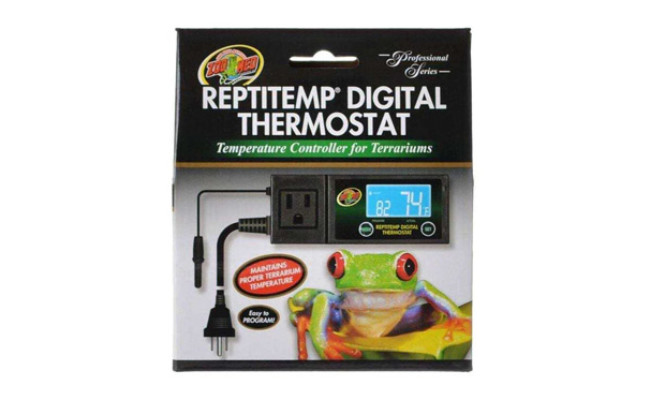
The Zoo Med ReptiTemp Digital Reptile Thermostat is just what you need to keep your reptile habitat at the right temperature. It’s a digital thermostat that will trigger a switch to turn on your heating device when the temperature gets too cold and turn on a cooling device should the temperature get too hot.
The digital thermostat can keep your habitat at temperatures between 50 degrees to 122 degrees F. It is compatible with heating devices up to 600 watts and cooling devices up to 150 watts.
Digital thermostat for reptile habitats
Turns on cooling devices and heating devices
Maintains a temperature of 50 degrees to 122 degrees F
Compatible with heating devices up to 600 watts and cooling devices up to 150 watts
- Brand: Zoo Med
- Model: 231176
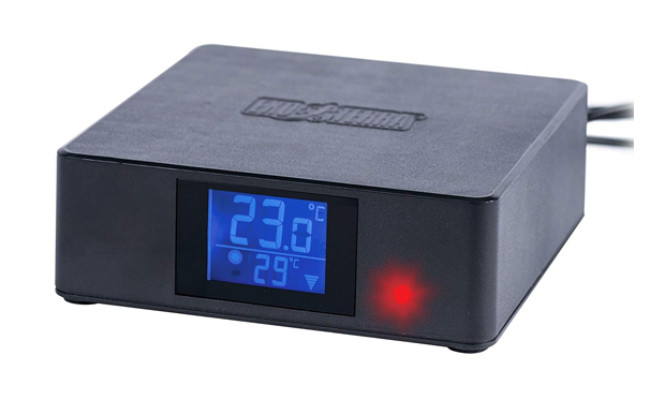
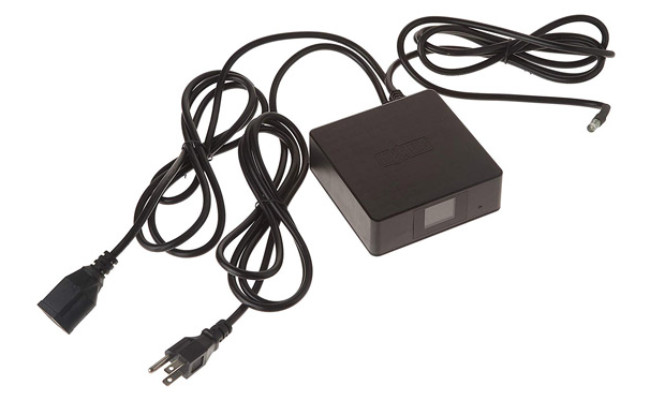


You can use this Exo Terra thermostat to maintain a comfortable and controlled heating system for your pet reptile that mimics that found in a tropical or desert environment. With this thermostat installed, you can be confident that your reptiles will not overheat or get too cold. It is possible to set a daytime and a nighttime temperature separately.
The device will maintain a desired setpoint temperature with great accuracy and removes the threat of dangerous swings in temperature. It features an easy-to-read LCD screen which indicates both the actual and the set temperature. In the daytime, it will automatically increase brightness and dim it at night. It has a red light to indicate it is on and blue to indicate that the desired temperature has been reached. Any temperature between 50 degrees F and 140 degrees F can be specified.
The temperature probe on the Exo Terra thermostat has a light sensor so that it knows when to switch from day to night time settings and is waterproof so it can withstand humid conditions. All you have to do is plug in your heat mat or other heating device, set the desired temperature and place the heat sensor. Accidental changes to the set temperature are prevented by the push button system.
Can be set to daytime and nighttime temperatures
Waterproof sensor
Sensor is light sensitive to detect daylight
Maintains temperatures of between 50 degrees F and 140 degrees
- Brand: Hagen
- Model: 1.6 pounds
- Weight: PT2459
Best Reptile Thermostat Buying Guide
What to Consider When Buying a Reptile Thermostat
Before you rush out and purchase your reptile thermostat, take a look at the main things that you should consider.
- The type of heater you want it to work with
There are several types of heater and several types of thermostat so compatibility is an issue. You need to consider what type of heater you have (or intend to purchase) and ensure that it is compatible with the thermostat. Heat mats work best with mat stats but heat lamps work best with dimming thermostats and ceramic heaters suit pulse thermostats.
- The temperature range you want to achieve
The temperature that you are aiming for will depend on the type of reptile you are keeping as a pet. Some lizards like a much hotter basking spot than most other reptiles. Also think about the size of your enclosure. Large vivariums require larger heaters and that needs a more powerful thermostat. Check that the temperature range of the thermostat matches the temperature required by your reptile.
- The maximum resistive output
The thermostat will have a maximum figure for the power of the heater it can control. If you buy a 150 watt ceramic heater, you need to make sure that the thermostat can cope with this.
- Control of multiple devices
Some reptile thermostats will control two devices at the same time. This can be handy for maintaining different zones in the same tank or using with both a heating and cooling device.
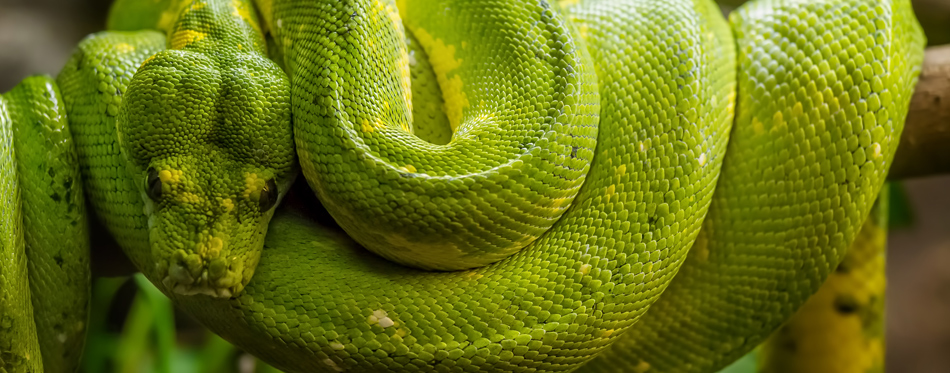
Why You Should Use a Reptile Thermostat
All reptiles are cold-blooded – the scientific name for this is an ectotherm. They rely on sources of heat that are outside their own body to maintain a healthy body temperature. In your vivarium (reptile enclosure) you must provide a source of heat such as a heat mat but in the natural environment, reptiles would use hot rocks or strong sunlight.
If your pet reptile does not have an adequate external heat source, they will soon become hypothermic. They will become less active, their digestion and immune system will slow down and they are prone to infection. Different species of reptiles have different optimum temperatures depending on where they would naturally live. It is vital that you know what that temperature is. For example, the required average temperature for a Desert Iguana is 65 to 85 degrees F but for a Green Tree Python it would be 70-85 degrees F.
Of course, the temperature outside the vivarium will also alter and so sometimes your heat source needs to be on and sometimes it needs to be off. Also, overheating can be an issue so there may be occasions here you need to use a cooling device. Overheating your reptile will cause their death much quicker than being too cool. The only way to accurately control this without constantly checking the temperature yourself is to use a thermostat.
Different Types of Reptile Thermostats
There are several different types of reptile thermostat to choose from. Sometimes you need a terrarium thermostat for a smaller tank or one that is more suitable for a larger vivarium. Here are the main categories.
- On/Off Thermostats
These are the simplest and cheapest type of reptile thermostat. They control the temperature by simply turning the heater on or off. You program the thermostat to a specific temperature and it tries to maintain this in between a tolerance level of a few degrees. Once the temperature has been reached, the power to supply to the heater is cut and it turns off. When the temperature falls, the power supply is turned on and the heater comes back on again.
It is a very basic and crude operation and there can be quite a gap between the on phase temperature and the off phase temperature. Most basic vivariums are heated with a spotlight bulb and when this is constantly going on and off it can be a bit annoying for the humans and a little distressing for the reptile! It can also cause the bulb in the heater to blow more often. However, it is certainly better than no thermostat at all. Many of the most common reptile pets are quite hardy and do okay with this style of thermostat despite its shortcomings. If you get an on/off thermostat for use with a heating mat, it will have a lower maximum power output.
- Dimmer Thermostats
Dimmer thermostats, such as the Habistat dimming thermostat, are very versatile and very popular with reptile keepers. They are a little bit more costly than the simple on/off thermostats but can be used with all sorts of heaters and do not have the drawbacks of the cheaper models. They work by constantly altering the power that is sent to the heater.
The sensor within the tank constantly measures the temperature. When the temperature has dropped below the specified temperature, the thermostat will send more power the bulb of the heater so that it produces more heat. This works on the same principle as a light dimmer switch in your home. When the temperature reaches the specified level, less power is sent and the bulb becomes dimmer and produces less heat. Because dimmer thermostats use a dimming action, the effect is less drastic and more subtle. The power changes are almost imperceptible. Therefore, there is no distressing flashing on and off of a light to deal with. The temperature within the tank is also more consistent and so they suit more sensitive species.
Dimmer thermostats are very efficient and accurate but they are also versatile. They can be used with any type of heat source and this makes them very popular with owners.
- Multiple Device Thermostats
Some thermostats are sophisticated enough to control multiple heat sources or a heat source and a cooling device. Some can be pre-programmed to manage several enclosures at the same time.
New models are constantly being introduced that have new sophisticated features. You just need to be sure that you understand how to operate it properly!
- Pulse Thermostats
A pulse thermostat can only be used with a heat source that does not emit light. Therefore, if you have a light bulb heater, this is not the one for you. They are usually used with ceramic heaters and are the thermostat of choice for sophisticated vivariums and for owners who wish to breed from their reptiles. Because there is no artificial light involved with the heater, they are capable of controlling the temperature in the day and at night separately which is important for some reptile species.
Pulse thermostats send a series of rapid and regular pulses of energy to a heater. When the temperature within the tank needs to be increased, they pulse harder and faster but when it has reached the required temperature, they pulse softer and slower. There is constant pulsing and this is why they cannot be used with a spotlight heater because it would be very unpleasant. The thermostat regularly senses and adjusts the temperature and this is very accurate. They work well with ceramic heaters and are slightly cheaper than the dimmer thermostats.
How to Set Up Your Reptile Thermostat
It is essential that you set up your reptile thermostat correctly. It will come with a full list of instructions and you should read these carefully. Also, it is a good idea to set up and monitor a new enclosure for a few days before you put your reptile in it to make sure that it is working correctly and safely.
It is likely that your new snake thermostat will have three cables leading out of it. The first cable will have a three pin plug on the end and this goes into your power supply. The next will be for the heater (this may be marked as ‘heater’) and the final one is for the sensor which will be placed inside the vivarium. Here are the steps that you will follow.
- Set up the heater at one end of the vivarium so that there is a temperature gradient.
- Position the thermostat sensor. It is best to put it at the center of the tank but it must not rest on the floor or walls as this will affect the temperature. Some owners drill a hole in a piece of cork and stick the sensor through it.
- Set the temperature on the thermostat to your required range – this varies by species and you will need to look it up or speak to an experienced reptile owner. Because the sensor is in the middle of the tank, you should set the temperature for the middle of the range. There will be warmer and cooler areas of the tank at either end.
- Plug the thermostat in and turn it on. It will take a few hours for the temperature to stabilize.
- Manually check the temperature at different locations in the vivarium using a thermometer. There should always be a location within the tank where your reptile can escape from the heat.
- Make any necessary minor adjustments but always wait for the temperature to stabilize after each one.
Safety Backups: When and Why They Are Needed
The failure of a snake thermostat can have disastrous implications. The tank could get much too hot or much too cold and this can seriously affect your reptile’s health and chances of survival. Thermostat failures are rare but can be caused by power surges, overloading or accidental pressing of buttons and dials. Most failures are actually caused by issues with the probe. These can become dislodged quite easily.
Thermostats that come with safety alarms are very useful in this situation. A loud buzzer will sound when there is an issue. So, if the probe does become dislodged the vivarium will not over-heat. As a further safety back up, some thermostats will shut off the power. You may want to consider getting a second, cheap thermostat as a safety back up. It is highly unlikely that they will both fail at the same time.
Best Reptile Thermostat FAQ:
Q: What is a reptile thermostat and how does it work?
A: A reptile thermostat is a device that you use with a heating device for a reptile vivarium. It controls when the heating device comes on and off by altering the electric signal that it receives. Thermostats have a sensor that is placed in the vivarium. You set a required temperature on the thermostat. Once the sensor detects that the specified temperature has been achieved, the thermostat turns off the heater or decreases its power. When the temperature drops again, the thermostat turns the heater back on or increases its power.
Q: I have a heat mat which thermostat shall I use?
A: The specification of each thermostat should state which appliances it is compatible with. Most are compatible with most heat mats. However, the dimming style of thermostats are better suited to basking lights.
Q: Can I run more than one heater off the same thermostat and if yes, how do I attach them?
A: It is perfectly possible to run two heaters or even one heater and one cooling device from the same thermostat provided it has been designed for this. It will be supplied with two sockets and so one device will be plugged into each one. Then you carefully specify the required temperature range and the thermostat will trigger cooling or heating as required.
Q: Can I use a Temperature Thermostat with a ceramic heater?
A: Ceramic heaters work well with some types of thermostat. On/off thermostats can be used with ceramic heaters because they are fairly robust and do not put out any light. Pulse proportional thermostats also work well with ceramic heaters because they respond quickly to changes in temperature. However, you cannot use a ceramic heater with a dimming thermostat as it is more effective for a basking light.
Q: How do I adjust the night time drop in temperature?
A: Some reptile species require the temperature to be a little lower at night. Some models of thermostat can detect daylight and can be set to adjust the temperature at night. Others have timers so you can set them at a cooler temperature at night time. New reptile owners can find this a little confusing so it may be better to start with a more robust species that does not require this change in temperature.

Our Top Pick
WILLHI WH1436A Temperature Controller 110V Digital Thermostat Switch Sous Vide Controller NTC 10K Sensor Improved Version
Our top pick of the best reptile thermostat is easy to use and has no complicated wiring. The maximum power load is 1100W at 110V and it can be used with a heating or a cooling device. It features a 9.8 feet long sensor cable and can be set to Celsius or Fahrenheit temperature.
The temperature probe is waterproof and durable. The difference of the temperatures can be 2 degrees and can be a minimum -58 degrees F to 230 degrees F. The device has an accuracy of 0.5 and can be calibrated. There is a high and low temperature alarm and an auto shut off timer.
Source:
- Laurie Hess, DVM, Hypothermia in Reptiles, PetMD
Sharon is a Ph.D. scientist and experienced pet content writer. As a life-long animal lover, she now shares her family home with three rabbits, a Syrian hamster, and a Cockapoo puppy. She has a passion for researching accurate and credible information about pets and turning it into easy-to-understand articles that offer practical tips. When it comes to our furry friends, she knows that there is always something new to learn!
Related Posts
